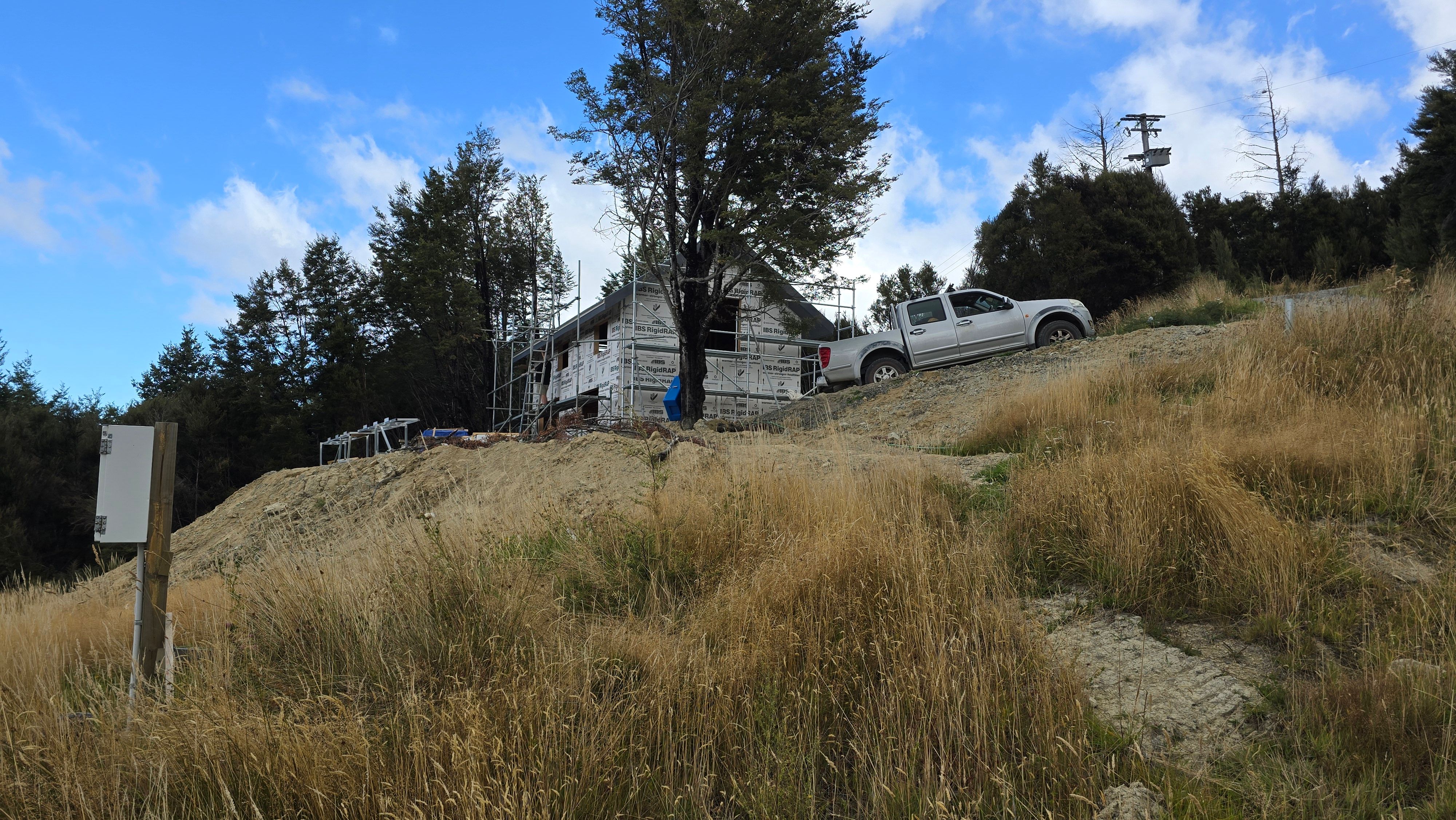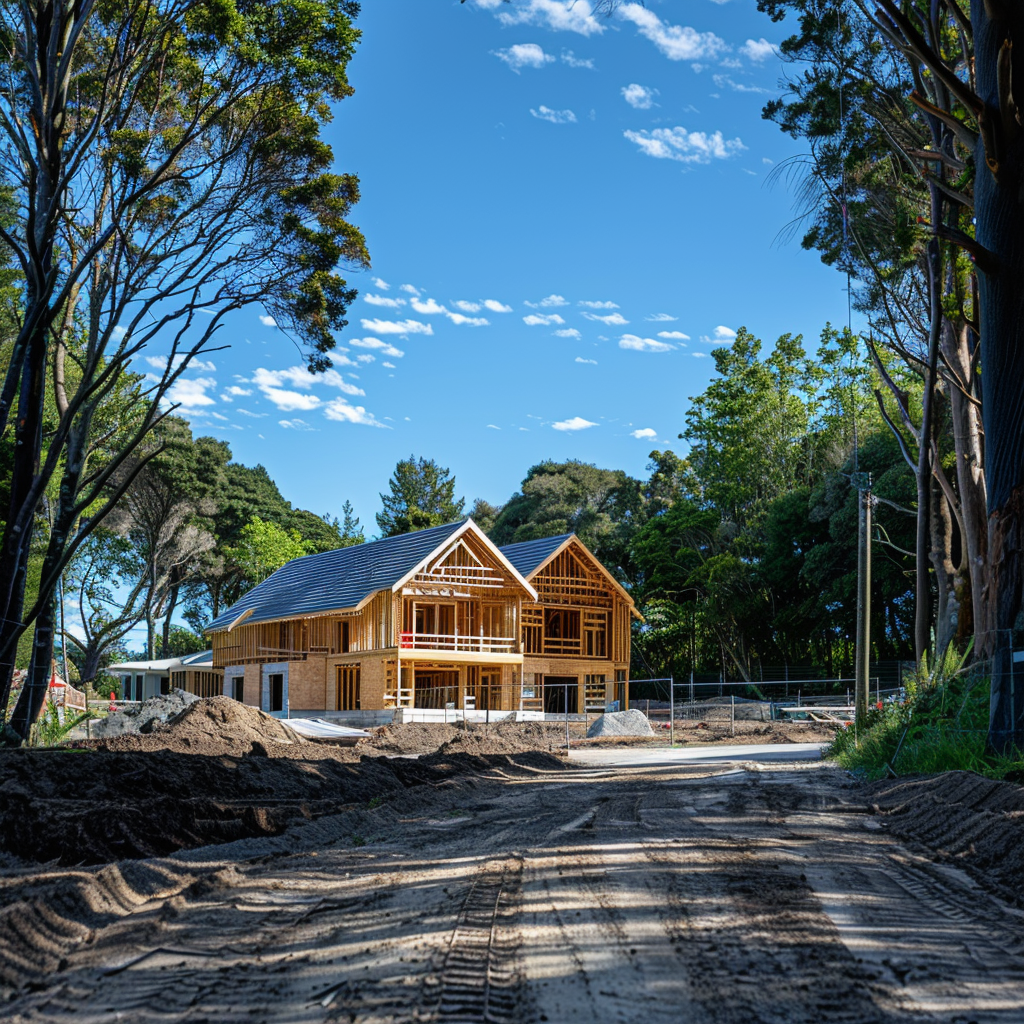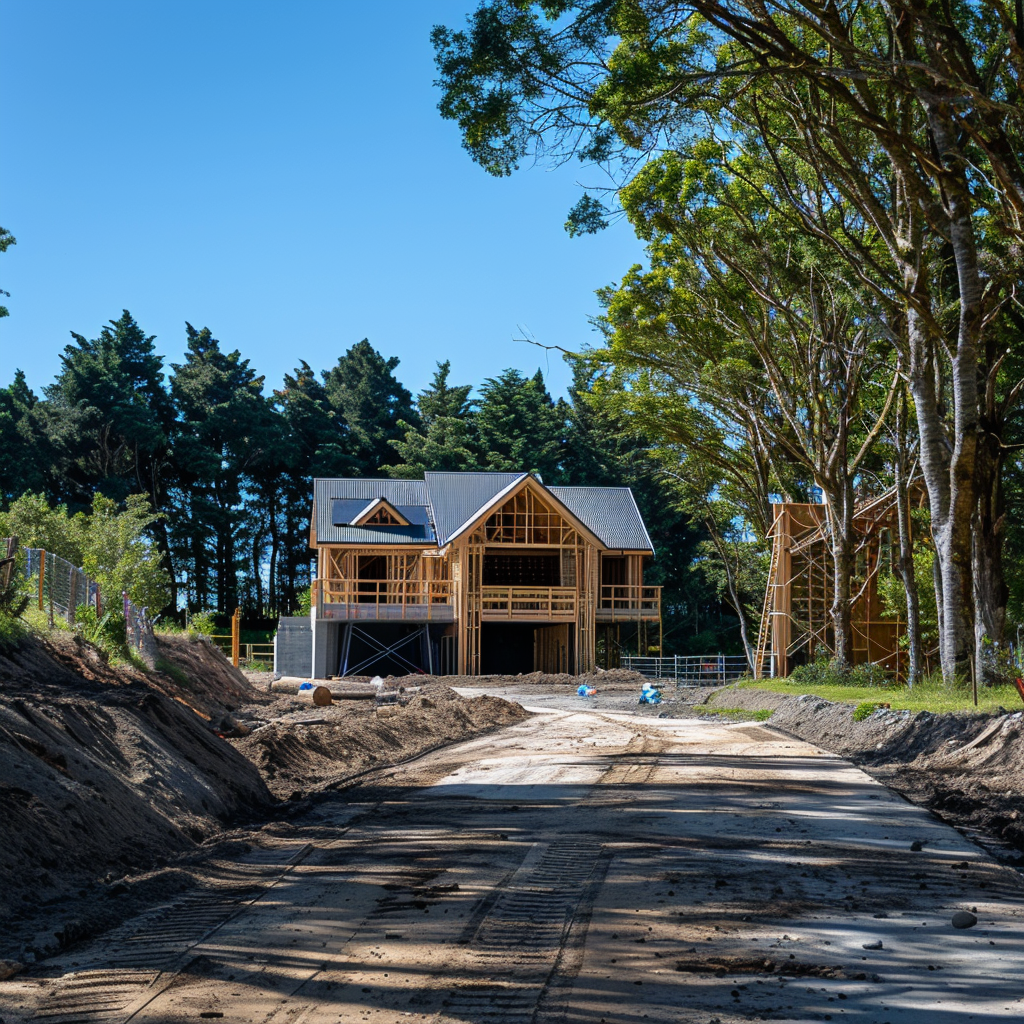Land Terrain Types And Their Influence on Building
Starting a building project in New Zealand involves navigating a variety of opportunities and challenges, which are significantly shaped by the country's diverse range of land terrains. Here are a selection of terrain types and their respective Pros and Cons of choosing that land type.
Urban Flat Land with Services Available
Pros for Living
High Accessibility to Amenities and Urban Lifestyle: Living in urban areas on flat land that already has services available offers unparalleled access to a wide array of amenities. From cafes, restaurants, and shopping centres to public transport options and healthcare facilities, everything you need is just a stone's throw away. This convenience enhances daily life, reducing the need for lengthy commutes and providing more time for leisure and relaxation. Additionally, the urban lifestyle is vibrant and dynamic, offering a plethora of cultural, entertainment, and social opportunities. Whether it's attending live concerts, visiting art galleries, or enjoying the nightlife, urban centres are hubs of activity that cater to a wide range of interests and preferences.
Cons for Living
Higher Population Density and Potentially Less Privacy: One of the trade-offs of urban living is navigating the challenges posed by higher population density. This can translate into busier streets, more noise, and generally a faster pace of life. For some, this environment is exhilarating; for others, it may feel overwhelming. Privacy can also be a concern, as residential and commercial developments are often closer together, reducing the sense of personal space. The hustle and bustle of urban life are not for everyone, and those seeking a quieter, more secluded living environment might find these aspects less appealing.
Pros for Budget
Reduced Initial Infrastructure Costs Due to Available Services: One of the significant advantages of opting for urban flat land with services available is the reduction in initial infrastructure costs. Since the essential utilities such as water, electricity, gas, and telecommunications are already in place, developers and homeowners can save substantially on the costs associated with installing these services. This advantage can make urban projects more financially viable, especially for developers aiming to maximise their investment returns or homeowners looking to build their dream home without incurring additional infrastructure expenses.
Cons for Budget
Higher Land Costs in Urban Areas: The convenience and appeal of urban living come with a higher price tag, particularly when it comes to purchasing land. Urban flat land with services available is in high demand, driving up prices and making it a significant investment. For those looking to buy in these areas, the cost of entry can be a considerable barrier. Developers and investors need to weigh the higher initial outlay against the potential returns on investment, which can be influenced by the location's desirability, the current real estate market, and future development prospects.
Urban Flat Land with Services Not Available
Pros for Living
Opportunity for Value Appreciation as Services are Developed: Opting for urban flat land without existing services presents a unique advantage – the potential for significant value appreciation. As infrastructure and services are introduced and the area develops, property values are likely to increase. This scenario offers a blank canvas for pioneering individuals and developers ready to shape the future landscape of their urban environments. The anticipation of growth and the chance to be at the forefront of an evolving community can be highly appealing.
Cons for Living
Initial Lack of Local Amenities and Services: The major drawback of choosing urban flat land without services is the initial absence of local amenities. This can mean everything from grocery stores to healthcare facilities and schools might be inconveniently far away or non-existent in the early stages of development. This lack of convenience can impact daily life, requiring residents to travel further for basic necessities and services.
Pros for Budget
Lower Purchase Price Due to Lack of Services: Financially, the absence of services translates into a lower purchase price for the land. This affordability can provide a more accessible entry point into the urban property market for buyers who might be priced out of more developed areas. The lower initial investment also offers an opportunity for higher returns as the area develops and services are established.
Cons for Budget
Higher Upfront Costs for Infrastructure Development: The flip side of the budgetary considerations is the higher upfront costs required to develop the necessary infrastructure. This includes everything from connecting to water and power utilities to potentially contributing to the development of roads and telecommunications. These costs can add up quickly and need to be carefully factored into the overall budget and financial planning of the project.
Urban Sloped Land with Services Available
Pros for Living
Unique Home Designs with Potential Views: Urban sloped land with services available offers a distinct advantage for creative and bespoke home designs that can capitalise on the terrain to enhance views and architectural interest. This terrain allows for innovative constructions that integrate the natural landscape, offering potentially stunning views of the urban environment. Such properties often stand out in the real estate market, attracting buyers looking for unique homes that differ from standard designs.
Cons for Living
Challenges in Construction Can Limit Design Options: While the sloped terrain offers unique design opportunities, it also comes with its own set of construction challenges. These can include limitations on the size and type of building that can be safely constructed, increased structural requirements, and potential difficulties with access during and after construction. These factors can limit design options and require careful planning and expertise to navigate.
Pros for Budget
Unique Properties May Command a Higher Resale Value: The uniqueness of homes built on sloped land, combined with the potential for impressive views, can significantly enhance resale value. Properties that successfully leverage the landscape's distinct characteristics to offer something exceptional in the urban market can attract premium pricing, making them potentially lucrative investments.
Cons for Budget
Increased Construction Costs Due to Sloping Terrain: The sloped nature of the land inevitably leads to higher construction costs. These can stem from the need for specialised foundation work, retaining walls, and additional landscaping to manage water runoff and soil stability. Such complexities add to the overall budget and must be carefully considered in the project's financial planning.
Urban Sloped Land with Services Not Available
Pros for Living
Secluded Homes in Urban Areas: Urban sloped land without services presents a unique opportunity to create custom, secluded homes that stand out from the typical urban sprawl. This setting offers a blend of privacy and exclusivity, allowing for innovative architectural designs that capitalise on the natural terrain to provide stunning cityscape or natural views.
Cons for Living
Significant Challenges in Access and Development: The sloped nature of the terrain combined with the lack of readily available services can pose significant logistical challenges. Access might be difficult, requiring substantial groundwork and engineering solutions to make the site viable for construction. These challenges can limit the type and scope of development that can be realistically undertaken.
Pros for Budget
Lower Initial Land Cost: Often, the purchase price for sloped land lacking services is lower than that of flat, serviced land in urban areas. This lower initial investment can be appealing to those who are willing to tackle the challenges associated with developing such properties.
Cons for Budget
High Costs for Both Terrain Management and Service Installation: While the initial cost of acquisition may be lower, the financial outlay required to manage the sloped terrain and install necessary services can be substantial. These include costs for excavation, retaining walls, and the extension of urban utilities to the site, which can significantly impact the overall budget.
Urban Bush-Covered Flat Land with Services Available
Pros for Living
Natural Surroundings with the Convenience of Urban Proximity: Living on bush-covered flat land in urban areas offers the best of both worlds – the tranquility and beauty of a natural setting combined with easy access to urban amenities. Residents can enjoy a serene environment, surrounded by greenery, while still being close to the conveniences of city life.
Cons for Living
Possible Restrictions Related to Land Clearing and Development: Development on bush-covered land may be subject to environmental regulations and restrictions to protect native flora and fauna. This can limit the extent to which the land can be cleared and what can be built, potentially complicating development plans.
Pros for Budget
Attractive for Niche Markets, Potentially Higher Resale Value: Properties that offer a unique blend of urban accessibility and natural beauty are highly attractive to certain market segments. This uniqueness can drive up demand and, consequently, the resale value of such properties, making them a potentially lucrative investment.
Cons for Budget
Additional Costs for Environmental Assessments and Clearing: Developing bush-covered land often requires environmental assessments to ensure compliance with conservation laws, alongside potential costs for safely clearing vegetation. These factors can add to the overall cost of development, impacting the budget.
Urban Bush-Covered Sloped Land with Services Available
Pros for Living
Unique Aesthetic and Privacy Within an Urban Setting: This type of land offers a distinctive living experience, combining the privacy and aesthetic appeal of a bush-covered, sloped environment with the benefits of urban living. It allows for creative, bespoke homes that truly stand out, offering residents a unique blend of nature and city life.
Cons for Living
Complexity in Building on Sloped, Bush-Covered Land: The challenges of constructing on sloped land are compounded by the presence of bush, requiring careful planning and construction techniques to preserve the natural landscape while ensuring stability and safety. This complexity can limit design options and increase project timelines.
Pros for Budget
High Value in Unique Property Market Segments: Properties developed on urban bush-covered sloped land can command a premium in the market, especially if they successfully leverage the site's unique characteristics to offer something truly special. This uniqueness can translate into a higher resale value, making it an attractive proposition for investors and developers.
Cons for Budget
Increased Costs for Clearing and Construction on Slopes: The combined challenges of managing sloped terrain and preserving the natural bush environment can lead to higher construction costs. These include specialised groundwork, retaining structures, and potentially more expensive building methods to adapt to the terrain and minimise environmental impact.
Suburban Flat Land with Services Available
Pros for Living
Ideal Family Environment with a Balance of Accessibility and Tranquillity: Suburban flat land with services available provides a perfect setting for families looking for a harmonious blend of convenience and peaceful living. These areas often feature spacious homes, safe neighborhoods, and access to quality schools, parks, and recreational facilities, fostering a sense of community and well-being.
Cons for Living
May Lack the Vibrancy and Diversity of Urban Centres: While the suburban setting offers numerous benefits, it may not match the dynamic atmosphere and cultural diversity found in more urban areas. Those seeking a wide array of entertainment options, dining experiences, and cultural activities might find suburban areas less stimulating in comparison.
Pros for Budget
Generally More Affordable than Urban Centres with Good Service Coverage: The cost of land and property in suburban areas is typically lower than in urban centres, making it a more budget-friendly option for many. Additionally, the availability of services ensures that homeowners can enjoy modern conveniences without facing significant additional infrastructure costs.
Cons for Budget
Prices Can Be Inflated in Highly Sought-After Suburbs: In suburbs that are particularly desirable due to their location, amenities, or school zones, property prices can be significantly higher. This can make it challenging for first-time buyers or those on a tighter budget to secure property in these areas.
Suburban Flat Land with Services Not Available
Pros for Living
Potential for Appreciation as the Suburb Develops: Investing in suburban flat land without existing services can offer significant long-term benefits. As the suburb grows and infrastructure improves, property values are likely to increase, providing substantial appreciation for early investors.
Cons for Living
Initial Lack of Amenities and Possible Construction Delays: Early residents in these developing suburbs may find themselves without the full complement of amenities and services that more established areas enjoy. Additionally, the process of bringing services to the area can lead to construction delays, impacting the timeline for building homes and community facilities.
Pros for Budget
Lower Land Purchase Price: The absence of services typically results in a lower purchase price for the land, making it an accessible option for buyers with a vision for the future and the patience to see development plans come to fruition.
Cons for Budget
Additional Investment Required for Accessing Services: While the initial cost may be lower, significant additional investment may be required to bring essential services to the area. This can include costs for connecting to municipal water, sewer systems, electricity, and internet services, which can add up quickly.
Suburban Sloped Land with Services Available
Pros for Living
Offers Unique Vistas and Distinct Home Designs: The natural contours of suburban sloped land allow for creative and innovative home designs that maximise views and incorporate the landscape into the living space. This terrain can offer stunning vistas, enhancing the living experience and overall appeal of the property.
Cons for Living
May Require Extensive Landscaping and Foundation Work: The sloped nature of the terrain may necessitate additional landscaping and foundation work to ensure stability and usability of the land. This can include retaining walls, terracing, and specialised foundation solutions to manage slope-related challenges.
Pros for Budget
Unique Appeal May Increase Property Value: Homes built on sloped suburban land that effectively leverage the unique terrain can have a higher market appeal and resale value. The distinctiveness of these properties, especially those with exceptional views or innovative designs, can make them highly sought after.
Cons for Budget
Higher Building Costs Due to Sloping Terrain: The challenges associated with building on a slope—such as the need for specialised construction techniques, additional engineering, and potential land stabilisation measures—can lead to higher overall building costs. These factors must be carefully considered when budgeting for a project on sloped land.
Suburban Sloped Land with Services Not Available
Pros for Living
Opportunity for Creating a Unique Property in a Developing Area: This setting offers the potential to design a one-of-a-kind home that harmonises with the natural slope of the land. It's an appealing choice for those looking to craft a distinctive living space in an area that is on the cusp of development.
Cons for Living
Lack of Immediate Amenities and Infrastructure: The absence of services and amenities can be a significant drawback, necessitating travel to access basic necessities and community facilities. This can impact the overall convenience and quality of living in the early stages of the area's development.
Pros for Budget
Lower Cost of Land Acquisition: With services not yet available, the initial purchase price of the land is often lower, offering an affordable entry point into the property market for those willing to invest in the future potential of the area.
Cons for Budget
Significant Additional Costs for Development and Service Installation: The lack of existing services means that significant investment is required to make the land habitable and comfortable, including the costs associated with connecting to municipal utilities and possibly paving roads.
Suburban Bush-Covered Flat Land with Services Available
Pros for Living
Living Close to Nature with Suburban Conveniences: This type of land offers the rare combination of a natural, bush-covered setting within close proximity to suburban amenities and services. It's ideal for those who cherish privacy and a connection to nature without sacrificing convenience.
Cons for Living
Potential Restrictions on Land Use and Clearing: Environmental protections and local regulations may limit how much of the bush can be cleared and dictate the type of development permissible. These restrictions aim to preserve the natural landscape but can constrain building options.
Pros for Budget
Attractive to Buyers Seeking a Blend of Nature and Convenience: Properties that offer natural beauty along with access to suburban amenities tend to be highly desirable in the real estate market. This desirability can translate into a higher resale value and investment potential.
Cons for Budget
May Require Additional Investment in Land Clearing and Maintenance: The costs associated with responsibly managing and maintaining a bush-covered property, including clearing land for building while adhering to environmental guidelines, can add up, impacting the overall budget for development.
Suburban Bush-Covered Sloped Land with Services Available
Pros for Living
Unique Setting and Privacy in a Suburban Context: Combining the sloped terrain with lush bush provides a unique and private setting for homeowners. This type of land appeals to those looking for a home that offers both character and seclusion within a suburban environment.
Cons for Living
Construction Complexity Due to Terrain and Vegetation: The combination of sloped land and dense bush increases the complexity of construction. Designing and building a home that respects the natural topography and vegetation requires careful planning and possibly specialised construction techniques.
Pros for Budget
Distinctive Properties Can Demand Premium Prices: Homes built on bush-covered sloped land that successfully integrate the natural features of the site can become highly sought-after properties, attracting buyers willing to pay a premium for these unique characteristics.
Cons for Budget
High Construction and Landscaping Costs: The challenges of building on sloped, vegetated land can lead to higher costs related to construction, landscaping, and environmental management. These factors need to be carefully considered in the project budget.
Rural Flat Land with Services Available
Pros for Living
Spacious Living with Room for Extensive Development or Agriculture: Rural flat land with services offers the space and flexibility for a wide range of uses, from residential developments to agricultural ventures. It's an attractive option for those seeking a rural lifestyle with the benefits of modern conveniences.
Cons for Living
May Be Far from Urban Centres and Amenities: The rural setting can mean that shopping, healthcare, education, and other services are not as readily accessible, requiring longer travel times for basic amenities and social activities.
Pros for Budget
More Land for Your Money Compared to Urban Areas: The cost per acre of rural land is typically lower than that of land in urban or even suburban areas, allowing buyers to acquire more space for their investment. This affordability makes it possible to pursue larger-scale projects or simply enjoy a more expansive living environment.
Cons for Budget
Ongoing Costs for Utilities and Services May Be Higher Due to Distance: While services may be available, the cost of utilities and maintenance on rural properties can be higher, due to the costs associated with extending and maintaining infrastructure over larger distances and less densely populated areas.
Rural Flat Land with Services Not Available
Pros for Living
Ultimate Privacy and Self-Sufficiency: This type of land offers unparalleled privacy, away from the hustle and bustle of urban life. It's perfect for those seeking a tranquil lifestyle and the opportunity to be self-sufficient, embracing practices like farming and renewable energy.
Cons for Living
Isolation and Lack of Immediate Access to Services: The remote nature of rural flat land without services can lead to feelings of isolation. Additionally, the lack of access to essential services such as supermarkets, healthcare, and schools may pose significant challenges.
Pros for Budget
Lower Land Costs: The absence of services often results in lower purchase prices for the land, making it an accessible option for those looking to buy larger parcels without the high costs associated with urban or serviced rural areas.
Cons for Budget
Significant Investment Needed for Self-Sufficiency and Services: While the initial land cost might be lower, the investment required to develop infrastructure for water, electricity, and waste management can be substantial, potentially offsetting the initial savings.
Rural Sloped Land with Services Available
Pros for Living
Picturesque Landscapes Suitable for Unique Homes or Tourism: The natural beauty and unique topography of rural sloped land offer a perfect backdrop for constructing one-of-a-kind homes or developing tourist accommodations, capitalizing on the scenic views to attract visitors or provide a dream living environment.
Cons for Living
Limited Development Options Due to Terrain: The sloped nature of the land can restrict the type and scale of development that can be undertaken, requiring innovative design and construction techniques to navigate the topographical challenges.
Pros for Budget
Potential for Niche Market Appeal: Properties on sloped land with striking views and unique characteristics can appeal to niche markets, potentially driving up property values and offering lucrative returns on investment.
Cons for Budget
Higher Costs Associated with Construction on Sloped Terrain: Building on slopes often entails additional costs for foundation work, land stabilisation, and infrastructure adaptation, which can significantly increase the overall investment required.
Rural Sloped Land with Services Not Available
Pros for Living
Seclusion and a Strong Connection to the Natural Environment: This land type appeals to those seeking solitude and a deep engagement with nature, offering a unique opportunity to live in a minimally disturbed natural setting.
Cons for Living
Accessibility and Construction Challenges: The combination of a sloped landscape and the absence of services can make access and construction difficult, limiting the feasibility of certain types of development and requiring significant effort to build.
Pros for Budget
Land May Be Acquired at a Lower Cost: The challenges associated with rural sloped land without services often result in lower acquisition costs, making it an attractive option for buyers with the vision and resources to tackle these obstacles.
Cons for Budget
High Costs for Infrastructure and Adapting to the Terrain: The financial outlay required to develop essential services and adapt construction methods to the sloped terrain can be considerable, potentially exceeding the initial savings made on land purchase.
Rural Bush-Covered Flat Land with Services Available
Pros for Living
Serene, Natural Setting with Some Accessibility to Services: Offering a peaceful living environment amidst nature, this land type provides the benefits of rural tranquility with the added advantage of available services, striking a balance between isolation and convenience.
Cons for Living
May Face Limitations on Clearing and Development: Environmental regulations aimed at preserving natural bushland can impose restrictions on how much land can be cleared and what types of structures can be built, potentially limiting development plans.
Pros for Budget
Unique Living Environment That Could Attract Premium Buyers: The appeal of living in a natural setting with the convenience of services can make these properties highly desirable, potentially attracting buyers willing to pay a premium for such unique attributes.
Cons for Budget
Costs for Environmental Compliance and Potential Land Clearing: Adhering to environmental guidelines and the potential need for clearing parts of the land for development can incur additional costs, impacting the overall affordability of the project.
Rural Bush-Covered Flat Land with Services Not Available
Pros for Living
Ideal for Those Seeking an Off-Grid Lifestyle or Conservation Projects: This land type is perfect for individuals or communities dedicated to sustainability, conservation, and living in harmony with the environment, offering a canvas for off-grid and eco-friendly projects.
Cons for Living
Very Limited Access to Amenities and Services: The lack of services means residents must be self-reliant and prepared for the challenges of living off-grid, including limited access to conventional amenities and the need for alternative solutions for water, power, and waste.
Pros for Budget
Low Purchase Price: The initial cost of purchasing rural bush-covered flat land without services can be relatively low, providing an affordable option for those committed to developing a sustainable and self-sufficient lifestyle.
Cons for Budget
Significant Investment in Sustainability and Self-Sufficiency: The costs associated with establishing off-grid infrastructure, such as solar panels, water harvesting systems, and waste treatment solutions, can be substantial, requiring careful financial planning.
Rural Bush-Covered Sloped Land with Services Available
Pros for Living
Unique Eco-Tourism or Bespoke Residential Opportunities: The combination of natural bushland, sloping terrain, and available services creates unique opportunities for eco-tourism ventures or custom-built residences that integrate seamlessly with the environment.
Cons for Living
Development Challenges Due to Terrain and Vegetation: The sloped and vegetated landscape requires thoughtful design and construction approaches to preserve the natural setting while ensuring stability and sustainability, posing challenges to development.
Pros for Budget
Attractive for Specific Markets, Potentially Yielding High Returns: Properties that capitalise on their unique environmental and topographical features can appeal to niche markets, including eco-tourism and luxury residential buyers, offering the potential for high investment returns.
Cons for Budget
High Initial Development and Environmental Management Costs: The costs involved in developing sloped, bush-covered land, from constructing access roads to managing vegetation and ensuring environmental compliance, can be considerable, affecting the project's budget.
Rural Bush-Covered Sloped Land with Services Not Available
Pros for Living
Extreme Privacy and Immersion in Nature: For those seeking total seclusion and a profound connection with the natural world, this land type offers an unparalleled opportunity to live immersed in a pristine environmental setting, away from the trappings of modern life.
Cons for Living
Difficult Access and Limited Development Potential: The absence of services, coupled with challenging terrain and dense vegetation, significantly limits access and the potential for development, making it suitable only for those with the dedication and resources to overcome these obstacles.
Pros for Budget
Low Land Acquisition Costs: The difficulties associated with developing this type of land are often reflected in lower purchase prices, making it an affordable option for those up to the challenge of unlocking its potential.
Cons for Budget
Substantial Investment in Infrastructure and Sustainable Solutions: The costs of establishing basic infrastructure, such as roads, utilities, and environmentally sustainable systems, can be high, requiring a significant financial commitment to develop the land responsibly.
Keywords for Search:
building on sloped land in new zealand, urban land development nz, impact of terrain on construction nz, new zealand urban flat land benefits, challenges of building on bush-covered land, cost of urban land with services nz, building a house on sloped land pros and cons, urban vs. rural land development in new zealand, best terrain for building homes in nz, urban land without services building guide, pros and cons of suburban land in nz, new zealand land terrain types for building, impact of land type on property value nz, choosing the right land terrain for building in nz, how land terrain affects construction costs nz, developing rural sloped land in new zealand, building regulations for different land terrains nz, investment potential of different land terrains nz, new zealand building sites terrain challenges, urban lifestyle benefits on flat land nz, environmental impacts of land development nz, services availability impact on land development nz, suburban vs. rural building sites in new zealand, cost-effective land types for building in nz, advantages of building on serviced land in nz






